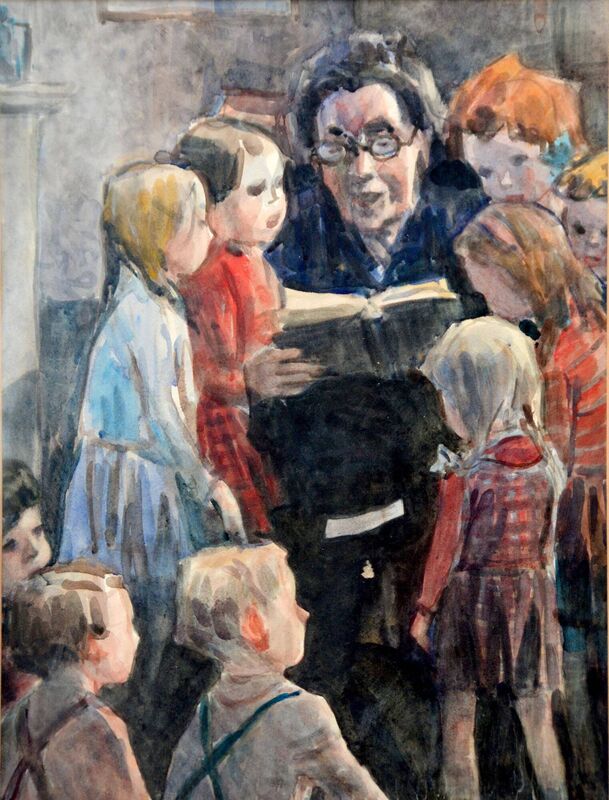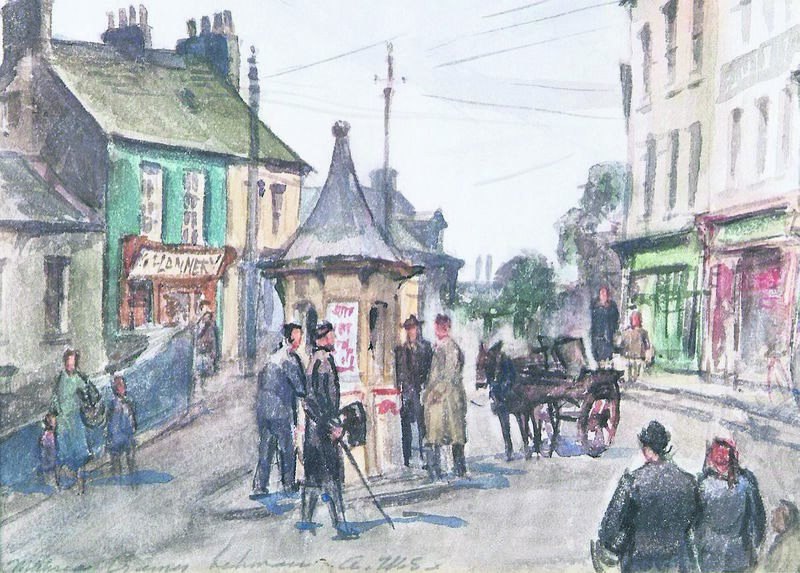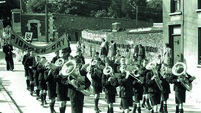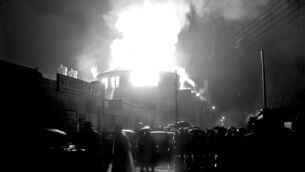The mystery surrounding a painting of Cork school teacher

YOU may remember that picture of the kindly teacher reading to her young pupils which we featured in Throwback Thursday on September 29.
I was hoping somebody would remember that lovely little school on Summerhill, run by Miss Cahill.
The first to respond to our article was Mary Horgan from the Local Studies Department at the city library.
“I wonder if the painting of Miss Cahill’s school might be by Soirle MacCana (1901-1975), who was Principal of the Crawford Municipal School of Art from about 1937 to 1967?” asked Mary.
“The style reminds me of his work, and he was based in Cork in the late 1950s, the date that you suggest for the painting.”
I didn’t think so, because even though I myself was only nine or so at the time, I knew the artist was a woman, and American, but it was so nice of Mary to write and suggest him.
Soirle, incidentally, produced some fine Holly Bough covers back in the day.

Then the totally unexpected happened! Billy Collins wrote to say he had been looking closely at the picture, and identified the artist as an American by the name of Mahrea Cramer Lehman (1896-1991).
“She lived in Cork for a while in the 1950s/’60s. She was a gifted and experienced artist, and some of her work is still on exhibition in the Art Gallery in Emmet Place.
“Mrs Lehman was friendly with my mother and was often in our house in Dillons Cross. We have a couple of her pictures. One of them is of me in my First Communion suit (1954). My mother knew Miss Cahill very well and used to visit the house in Empress Villas. In my memory there were two sisters there.”
There were, Billy, there were. Miss Maureen Cahill, who did the teaching, and her sister, Miss Dove, who kept house and did the cooking.
“It’s possible that my mother introduced Mrs Lehman to them,” continues Billy.
“Her style is to me unmistakeable. She worked live, using watercolours directly with amazing confidence and skill - no preliminary sketches, no pencil, no photograph.
“The picture would have been finished before Miss Cahill finished reading the story.”
Mr Collins then looked online and found some more information about Mrs Lehman, including that her work is still sought after.
“She was married in Chicago to another artist, Paul Lehman, who unfortunately walked out an upstairs window and was killed. She then came to Europe by herself and lived with the gypsies before coming to Ireland.
“Eventually, she finished up in a hotel suite in Greenwood, Mississippi, as part of a group of artists.”
I wrote back to tell Billy how delighted I was to identify this artist at last, and coaxed him to tell me more about growing up at Dillon’s Cross.
Mossy, the man who used to deliver vegetables to the Kerrigan family home, called it Clankytane, which I alway thought a lovely name. Yes, Billy remembers Mossy.
“He was a gentle and decent man, although I didn’t really know him well. But if you look at the old maps on the Ordnance Survey site, you’ll see that Clankittane is indeed a townland across the road from the Barracks. It’s called Glankittane on the map I looked at.
“There was a square of cottages known as Clankittane Square which I remember. My mother had another of her many friends who lived eventually in a house down towards the lower Barrack gate. She called it Clankittane House” And Billy promises faithfully to send us his own memories of growing up at Dillons’ Cross.
We wouldn’t mind seeing that Lehman painting of your First Communion either!
Of course, I got back on to Mary Horgan to tell her of this miracle identification of the artist, and she was as pleased as I was.
“I will look out for Mahrea Cramer Lehman at the Crawford. The Soirle MacAna painting that I was thinking of, in particular, was also of schoolchildren in class - a really sweet painting.”
Well, it would be nice to show it on this page, so we must get on to the Crawford and see if they will co-operate.

Having checked up on Mahrea Cramer Lehman myself, I know she did some lovely watercolours of Cork scenes - St Luke’s Cross with the toll booth, for example, and one of the narrow lanes leading into the English Market. They deserve to be better known.
We take the liberty of reproducing a small image of the St Luke’s Cross painting, but hope that the Crawford will let us use a better one, perhaps next week.
And still more on the same theme, and indeed the same area of old Cork.
Tim Cagney, who has regularly blessed us with his wonderful childhood memories, writes to say: “You recently wrote a little piece - more of an enquiry, really - on a school run by a Miss Cahill, on Summerhill. It reminds me very much of a similar establishment I attended (at around age five) which was run by a lady called Mrs Hobart, on New Road.
“I can’t remember what said road was previously known as, but I do have a memory of the change to New Road. It remains thus, to this day - God only knows when the New Road will ever become an Old Road! It links Gardiners Hill with Dillons Cross.
“I note Miss Cahill resided at Empress Place. I once knew a man who lived there. His name was Fred O’Dwyer, and he taught Art at CBC. My late father was a friend of his - I think they were members of a ‘card-school’. Fred never married, but lived with his spinster sister.”
Now, when it comes to teachers at Christians, I always turn to one reliable source, my brother Tom.
“Yes, yes, Freddie Dwyer. He wasn’t the worst of them, by any means. He was a very short man, and used to wear platform soles to compensate for the lack of inches. I envied him those soles so much! It was just about the time that teddy boys were coming into vogue, and thick-soled shoes were absolutely the thing. But my mother flatly refused to buy them for me, so that was that. Sensible lace-ups that would last the year out with luck were the rule.
“And the cobbler up at St Luke’s Cross could resole them if they wore out with all that walking we did in those days around the city.”
Tom also recalls Freddie warning him against walking down the Mardyke at night with young ladies because it was very dangerous. When Tom innocently asked why, Freddie said, ‘It’s so romantic, and you would never know what might happen!’
Alan Cambell writes to say that he really enjoys reading this Throwback Thursday page every week. “I can relate to so many of the stories from the ’50s & ’60s, and thought others might like to read of my own experiences in my early schooldays.
“I lived at Lancaster Quay on Western Road. How many people involved in treasure hunts across the city and have been asked where that is? It is, of course, not really a quay at all, at least in modern times, but rather a terrace of houses across the road from the south channel of the river Lee.
“My mother ran a shop there at No.2 and it became well known as a tuck shop for Presentation Brothers College.

“How many Pres boys will, I wonder, remember sitting on the counter having a bottle of red lemonade, or buying the now forbidden Player and a match for three old pence?
“Anyhow, to my first day at school, in September, 1954, aged four. I was sent to Christchurch National School, which was on the Grand Parade end of Christchurch Lane, now part of Bishop Lucey Park. It was a Church of Ireland school and had about 80 pupils in two classrooms in the 1950s.
Low & High Infants, 1st, 2nd and 3rd classes in one room with Miss Dawson teaching the lot, and the remaining, more senior kids were in the other room under the stern direction of Mr Price.
“I was frogmarched to the school by my mother and up the stairs to meet both teachers, who assured her I would be well looked after. My mother left and I was directed to the junior room. I was having none of it, however, and slipped out, down the stairs and up the lane after my mother.
“When I caught her up, she simply said: ‘Your father will be very disappointed that you didn’t stay in school’. She later told me that, without a word, I turned around and returned to the school, never to run away again!
“Now, Miss Dawson was a kindly teacher and she made the little ones feel happy by reading Noddy books to them. What that did for our education was questionable but I must have enjoyed it as I still remember it.
“The old school was freezing, the only heating being an open coal fire, and Miss Dawson was constantly complaining about the cold. This must have reached a crescendo, because when we came in one morning the caretaker had installed four oil heaters. They were all rather elderly models with ‘pot bellies’, and sat on 4 legs. Except that one had only three legs.
“Of course, the inevitable happened: some child rushing past it knocked it, over it went, paraffin leaked across the floor and immediately went up in flames.
“The pupils squeezed into the corner screaming, while Miss Dawson ran to get the Principal. In came Mr Price, carrying a sheet of 3 ply, fortunately left after some recent building repairs, threw it on the blaze and jumped on it.
“It put out the fire but we had a large black mark on the floor ever after.”
Alan is certain that if little kids got such a fright today, they would have counselling, a few days off, and possibly a visit to a solicitor’s.
“Not in 1954. We were told to go back to our desks and get on with our work. Thank goodness, we lived to tell the tale!”
Great stuff, Alan, and thank you so much for sharing.
Now listen, next weekend brings Halloween or Samhain, the Celtic New Year, with all its traditions and ghostly aspects. How many of you have a ghost story of your own to relate to the rest of us? We’d like to feature some of them next Thursday.
So, get thinking, recall that inexplicable event which made your spine creep, and tell us all about it.
We already know of the Haunted House off Lover’s Walk, thanks to Tim Cagney and others, but now we want to hear of other residence or laneways or locations said to be haunted.
Email them tojokerrigan1@gmail.com or leave a comment on our Facebook page: @echolive.ie.







